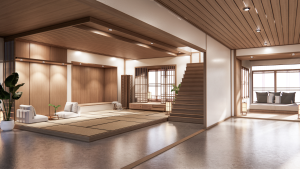Home improvement projects can transform a living space into a personalized haven. DIY home improvement projects not only enhance a home’s aesthetic appeal but also increase its value, making it a worthwhile investment. Whether it’s refreshing a room with new paint or tackling a larger renovation, countless options are available for homeowners looking to make impactful changes.
Engaging in DIY tasks allows individuals to express their creativity while also saving money compared to hiring professionals. Successfully completing projects like building custom shelves or updating fixtures gives a sense of accomplishment and pride. The flexibility of DIY projects means they can be adjusted to fit any home style and budget.
Those interested in enhancing their homes will find ample inspiration and resources for various DIY home projects. From simple tasks to more complex renovations, there are ideas suitable for all skill levels that contribute to a welcoming and functional living environment. Your next project might be just around the corner, waiting to be explored.
Planning Your DIY Home Improvement Projects
Effective planning is crucial for successful DIY home improvement projects. It involves assessing the existing space, establishing a budget, and setting project priorities. This structured approach ensures a more organized and efficient workflow.
Assessing Space and Needs
Begin by evaluating the current state of the home. Walk through each room and identify areas requiring improvement.
- Functionality: Determine how each space is used. For example, a cluttered kitchen may benefit from better storage solutions.
- Aesthetics: Note any cosmetic updates needed, such as paint or new fixtures.
Take measurements and document the layout. This information will inform design choices and material selections. A clear understanding of needs helps in deciding which projects will have the greatest impact.
Setting a Realistic Budget
Establishing a budget is essential to avoid overspending. Consider the following steps:
- Research Costs: Gather information on materials, tools, and labor expenses.
- Allocate Funds: Set aside a specific amount for each project.
It may be useful to create a simple budget table:
|
Project |
Estimated Cost |
|
Kitchen Upgrade |
$1,500 |
| Bathroom Refresh |
$800 |
| Living Room Revamp |
$1,200 |
Include a contingency fund of 10-20% for unexpected expenses. This preparation prevents financial strain during the process.
Prioritizing Projects
After assessing needs and setting a budget, it’s time to determine project priorities.
- Impact: Focus on projects that enhance both functionality and aesthetics.
- Feasibility: Some projects may require skills or tools the homeowner does not possess.
Rank projects based on urgency and cost-effectiveness. For instance, upgrading the kitchen might take precedence over cosmetic changes in the living room.
Creating a timeline for each project is also beneficial. It helps in maintaining momentum and meeting set goals.
Detail-Oriented Projects
Attention to detail can elevate home improvement projects significantly. By focusing on specific techniques and materials, individuals can achieve impressive results that enhance both functionality and aesthetics.
Painting Techniques and Wallpaper Application
Selecting the right paint and techniques can transform a room. Different finishes—such as matte, satin, and gloss—affect the room’s atmosphere. Choosing paint colors that complement furnishings is crucial for a cohesive look.
Wall preparation is vital before applying paint or wallpaper. Ensure the surface is clean and smooth by filling holes and sanding rough areas. For wallpaper application, measuring the wall accurately prevents wastage.
When applying paint, use high-quality brushes and rollers for a smoother finish. Utilize painter’s tape to achieve clean edges and sharp lines. Applying two coats of paint often results in richer color depth.
Installing Crown Molding and Trim Work
Crown molding adds sophistication to any ceiling. Proper measurement is key when cutting the molding at 45-degree angles for corners. Use a miter saw for accurate cuts and secure the pieces with finishing nails.
Prioritize surface preparation. Fill any gaps with caulk to ensure a seamless look. Painting the molding before installation can simplify the process and minimize the mess.
Applying baseboards and trim requires similar attention. Measure carefully and use a level to ensure straight lines. Trim can accentuate features like windows and doorways, enhancing the home’s overall design.
Creating Custom Shelving and Storage
Custom shelving solutions maximize space while offering a personalized touch. Floating shelves provide an elegant, modern look and can be installed with concealed brackets for a clean appearance.
In designing built-in bookcases, consider both dimensions and materials. Wood types like oak or pine can match existing decor. Using plywood can offer a cost-effective alternative while providing strength.
To enhance function, incorporate adjustable shelves. This flexibility allows homeowners to adapt storage for various items. Detailed planning will ensure that the shelving meets both needs and aesthetics, creating an effective and stylish storage solution.
Room-Specific Enhancements
Enhancing specific rooms within a home can significantly increase functionality and aesthetics. Certain improvements focus on practical upgrades, while others emphasize style, catering to individual preferences.
Upgrading Kitchens and Bathrooms
Upgrading kitchens and bathrooms can yield high returns on investment. Focusing on fixtures such as faucets and cabinet hardware can modernize the look without major renovations.
Installing a tile backsplash is an effective way to add personality and protect walls from splashes. Choosing durable countertops like quartz or granite can provide both elegance and functionality.
For bathrooms, consider replacing an outdated bathroom vanity with a more contemporary option that offers additional storage. Installing better light fixtures can also improve both utility and ambiance.
Revitalizing Living Spaces and Bedrooms
Revitalizing living spaces and bedrooms involves thoughtful furniture selection and layout adjustments. Updating bedroom furniture with modern designs can create a more inviting atmosphere.
In living rooms, opt for a mix of seating arrangements to improve comfort and maximize space. Incorporating new textiles, such as throw pillows and area rugs, introduces color and texture.
Using wall paint or removable wallpaper can transform the look of a room quickly. Adding accent pieces such as stylish lamps or artwork enhances the overall design and personal touch.
Designing an Efficient Home Office
Creating an efficient home office is essential in today’s work environment. Selecting the right desk and chairs can greatly impact productivity. Consider ergonomic options that cater to long hours of work.
Incorporate adequate storage solutions, like bookshelves or filing cabinets, to keep the workspace organized. Efficient cable management can prevent clutter and improve aesthetics.
Good light fixtures are important as well. Natural light options paired with task lighting can reduce eye strain and create a pleasant working atmosphere.
Exterior and Outdoor Projects
Enhancing the exterior of a home can significantly improve its appeal and functionality. Focused efforts in landscaping and creating inviting outdoor spaces transform backyards into usable, relaxing environments.
Landscaping and Gardening Enhancements
Landscaping starts with assessing the existing conditions of the yard. Key areas to focus on include soil quality, sunlight exposure, and water drainage. He or she can improve soil by adding organic matter such as compost, which enriches plant growth.
Plants can elevate visual interest. Selecting native species can reduce maintenance and water needs. Incorporating elements like pathways, flower beds, and borders organizes the space aesthetically.
Consider adding features such as a fire pit. It creates a focal point while offering a gathering space for friends and family. He or she should also maintain the garden with regular pruning and seasonal plantings to keep it vibrant.
Creating Outdoor Living Spaces
Outdoor living spaces extend the home’s indoor comfort to the outside. Including furniture like Adirondack chairs offers a cozy space for relaxation. These durable pieces are perfect for lounging near the fire pit.
Consider adding a patio or deck to facilitate dining and entertaining. Materials like wood or composite decking provide a durable foundation. Umbrellas or retractable awnings can offer shade during sunny days.
Incorporating decorative elements such as lanterns or outdoor rugs enhances the ambiance. He or she should consider specific layouts that promote social interaction, making the space inviting for gatherings.




